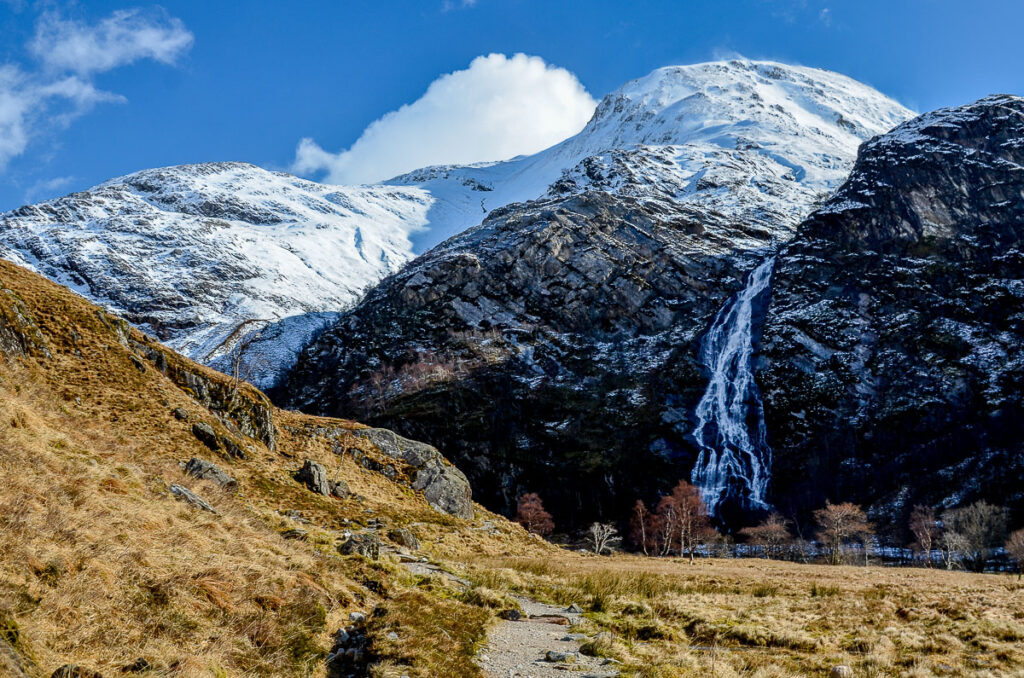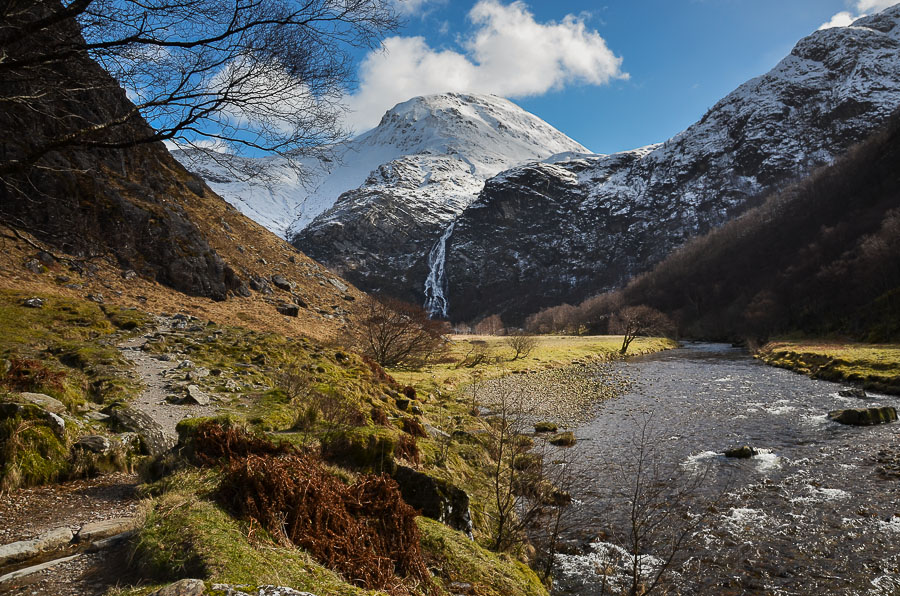Steall Waterfall, also known in Gaelic as An Steall Bàn meaning “The White Spout,” is one of the most dramatic and breathtaking natural landmarks in the Scottish Highlands. Cascading 120 metres (393 feet) down the steep cliffs of Glen Nevis, it is the second highest waterfall in Scotland and among the most striking in the UK. Surrounded by towering mountains, lush glens, and the raw beauty of Highland wilderness, Steall Waterfall is much more than a sight to see—it’s an immersive experience that combines history, legend, adventure, and the timeless grandeur of Scottish landscapes.

Location and Setting
Steall Waterfall is located at the head of Glen Nevis, a glen carved by glaciers and shaped over millennia into one of Scotland’s most scenic valleys. The glen lies just a short drive from Fort William, a Highland town already famed as the base for Ben Nevis, Britain’s highest mountain. The waterfall is reached via the Steall Gorge, a narrow, rocky passage that opens dramatically into a meadow known as the Steall Meadows or An Steall, where the falls tumble down from the slopes of An Gearanach, a peak of the Mamores mountain range.
The location feels remote, despite its proximity to Fort William. Dense woodland, fast-flowing rivers, and sheer-sided cliffs create an atmosphere of seclusion. For many visitors, the walk to Steall Waterfall is as unforgettable as the sight of the falls themselves.
The Walk Through Steall Gorge
The most popular way to reach the falls is by taking the Steall Gorge Walk, one of the best short hikes in Scotland. The path begins at the Upper Glen Nevis car park and extends about 2.5 kilometres (1.5 miles) each way, making it roughly a 5-kilometre (3-mile) round trip. Though relatively short, the walk is an adventure in itself.
The trail starts gently before quickly narrowing into the gorge. Here, hikers follow a rocky, sometimes uneven path that clings to the cliffs above the River Nevis. In places, the trail winds under overhanging rocks or crosses small streams, with steep drops to one side. The air is filled with the sound of rushing water and the scent of pine and moss, making the hike a feast for the senses.
After about 40 minutes of walking, the gorge opens suddenly into a wide, grassy meadow surrounded by peaks. At the far end of this meadow, Steall Waterfall reveals itself, tumbling in a long, silver ribbon from the cliffs high above. The transition from enclosed gorge to open glen is dramatic, and the waterfall provides the perfect focal point for the scene.
The Waterfall
Steall Waterfall is a single-drop fall, plunging 120 metres down the rock face in a narrow, powerful stream. Its sheer verticality makes it particularly striking, contrasting with the gentler cascades and multi-tiered waterfalls often found elsewhere in the Highlands. During heavy rainfall or snowmelt, the volume of water increases, turning the fall into a roaring torrent that echoes across the glen. In drier summer months, it becomes a slender ribbon of white against the dark cliff, graceful and elegant.
At the base, the River Nevis flows across the meadow, meandering through grassy banks and rocky channels. The water is clear, cold, and fast-moving, providing a vital habitat for fish, insects, and the birdlife of the glen.
The Wire Bridge
One of the most memorable features of the Steall Waterfall walk is the three-wire bridge across the River Nevis near the meadow. Made up of a single steel cable for walking and two hand cables for balance, it provides an adventurous way to cross the river. Though not for the faint-hearted, the bridge is sturdy and safe, and many visitors relish the chance to inch their way across with the falls in the background. Those who prefer not to use the bridge can still enjoy the view from the meadow, but the crossing is an experience in itself.
History and Legend
Steall Waterfall and Glen Nevis are steeped in folklore and history. The Gaelic name An Steall Bàn reflects not only the physical appearance of the waterfall but also the poetic tradition of describing Highland landscapes. Legends tell of giants and warriors inhabiting these mountains, and it is not difficult to see how the setting could inspire such tales.
One of the most enduring stories associated with the glen is that of clan battles. The MacDonalds and Camerons are said to have clashed in this area, and the narrow gorge would have been a formidable natural barrier in times of conflict.
More recently, Steall Waterfall has entered popular culture through cinema. The area featured in the Harry Potter films, particularly in scenes involving the Triwizard Tournament in Harry Potter and the Goblet of Fire. The wild beauty of Glen Nevis and the dramatic backdrop of the falls made it an ideal filming location for magical and adventurous moments.
Geology and Natural Formation
Like much of the Highlands, Glen Nevis and Steall Waterfall are products of geological forces spanning millions of years. The glen was shaped by glaciation during the last Ice Age, when vast glaciers carved out the U-shaped valley. Steall Waterfall formed as a hanging valley, where a smaller tributary valley meets the main glen at a higher elevation. The difference in height causes the river to plunge steeply, creating the dramatic single drop we see today.
The surrounding cliffs are composed mainly of schist and other metamorphic rocks, their rugged appearance shaped by erosion, frost, and water over countless centuries.
Flora and Fauna
The walk to Steall Waterfall offers rich opportunities for observing Highland wildlife. The gorge itself is thick with oak, birch, and Scots pine, with mosses, lichens, and ferns thriving in the damp, shaded environment. In summer, wildflowers brighten the meadows near the falls, adding colour to the green backdrop.
Birdlife includes buzzards, peregrine falcons, and dippers, while red deer often roam the hillsides. Otters and pine martens inhabit the rivers and woodlands, though they are elusive and rarely seen. The biodiversity of Glen Nevis makes it a valuable site for conservation, as well as a delight for visitors with an eye for nature.
Tourism and Accessibility
Steall Waterfall is one of the most popular natural attractions near Fort William. Its appeal lies in the combination of a manageable but adventurous walk, stunning scenery, and the sense of remoteness achieved within a short distance from town. The trail is suitable for families with older children, though the rocky sections of the gorge demand care and appropriate footwear.
In summer, the path can be busy, with visitors from all over the world coming to see the falls. In winter, conditions can be icy and treacherous, but for experienced hikers, the snow-covered glen and frozen waterfall offer a magical sight.
Tourism brings economic benefits to Fort William and the Lochaber area, supporting local accommodation, shops, and guiding services. However, with popularity comes responsibility, and conservation efforts aim to protect the fragile environment of the glen. Visitors are encouraged to follow the “Leave No Trace” principle, respecting wildlife and minimising their impact.
Conservation and Protection
Steall Waterfall lies within the Ben Nevis and Glen Coe National Scenic Area, one of 40 such designations across Scotland. This status helps to preserve the unique landscape and ensure that development does not compromise its natural beauty. Organizations such as the John Muir Trust and local authorities work to maintain paths, manage erosion, and promote responsible tourism.
Conservation is vital not only for protecting habitats but also for maintaining the wilderness character that makes Steall Waterfall so special. Without careful management, the combined effects of erosion, litter, and overuse could damage the very qualities that attract visitors.
Symbolism and Inspiration
Beyond its physical grandeur, Steall Waterfall has a deeper resonance for many who visit. Its Gaelic name—“The White Spout”—captures its purity and timeless presence, while its remote yet accessible location gives it a mythical quality. For artists, writers, and photographers, the falls offer endless inspiration, their form changing with the weather, the seasons, and the shifting light of the Highlands.
For walkers, the journey through the gorge and the sudden reveal of the waterfall can feel symbolic: a reward for perseverance, a reminder of nature’s scale, and a moment of connection with the wild.
Conclusion
Steall Waterfall is one of Scotland’s natural wonders, a place where geology, history, and legend converge in a spectacular Highland setting. From the adventurous walk through Steall Gorge to the sight of the white torrent plunging into the meadow, every step of the journey offers something to treasure. It is a landscape that invites exploration, reflection, and respect—a reminder of the raw power and fragile beauty of the Highlands.
For visitors to Fort William, a trip to Steall Waterfall is more than an excursion; it is an encounter with the spirit of Scotland itself.

